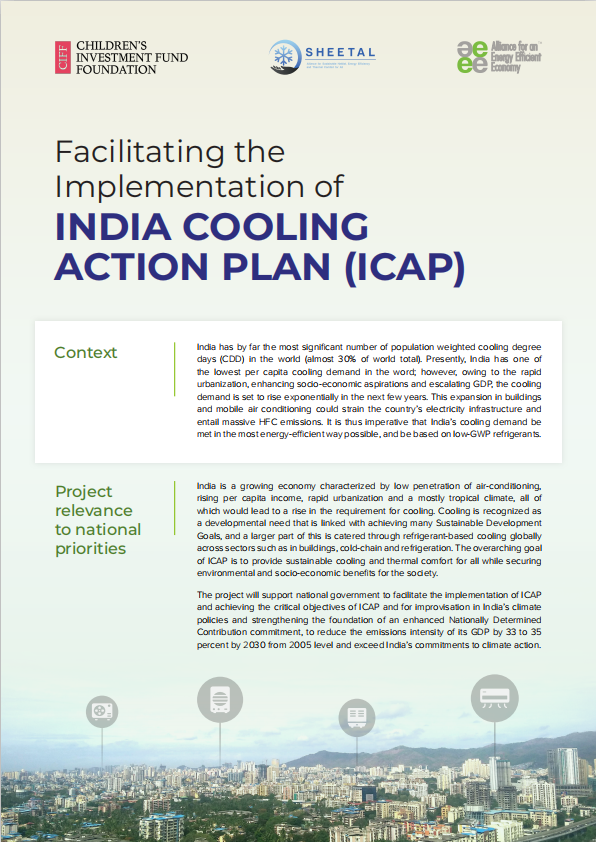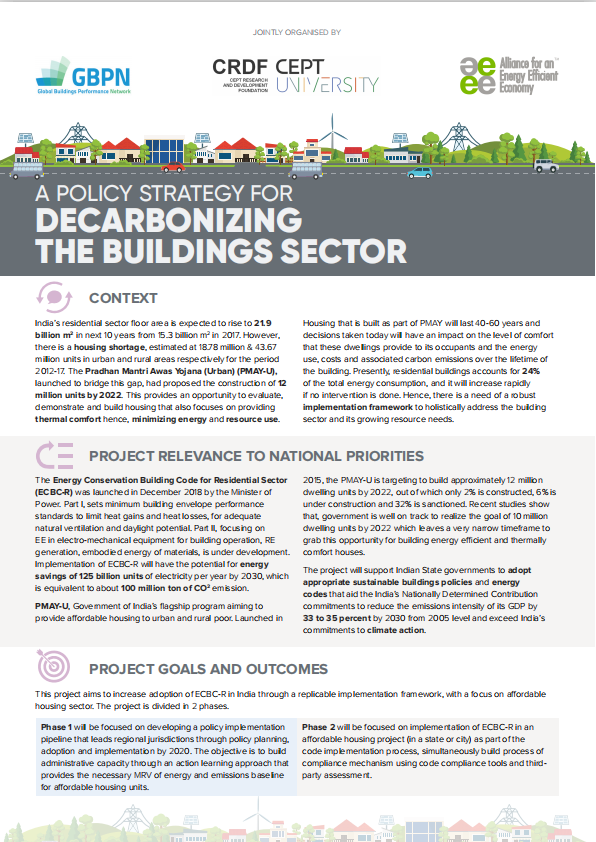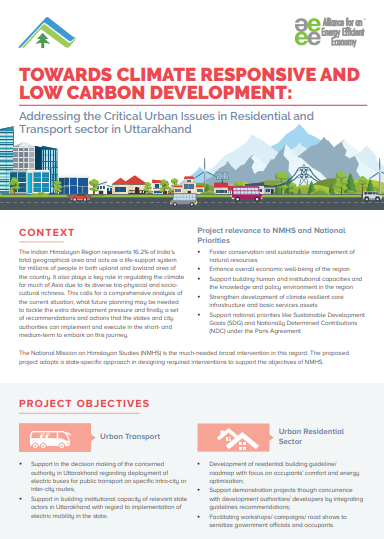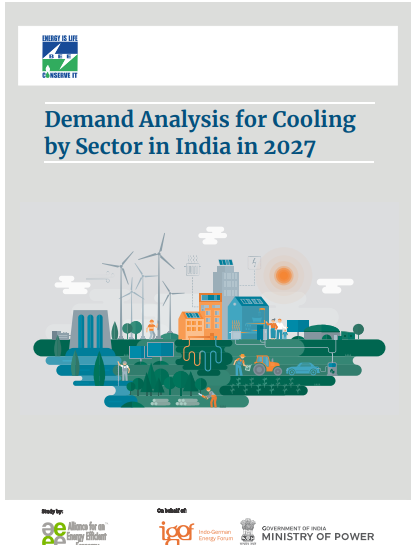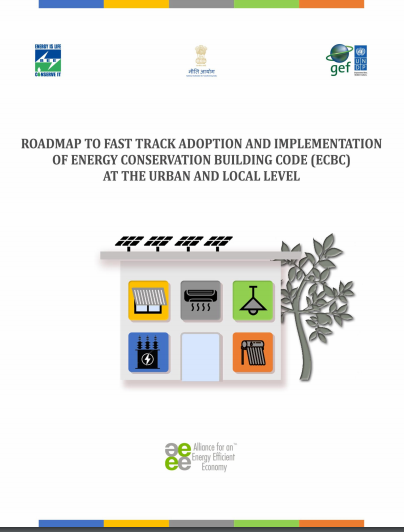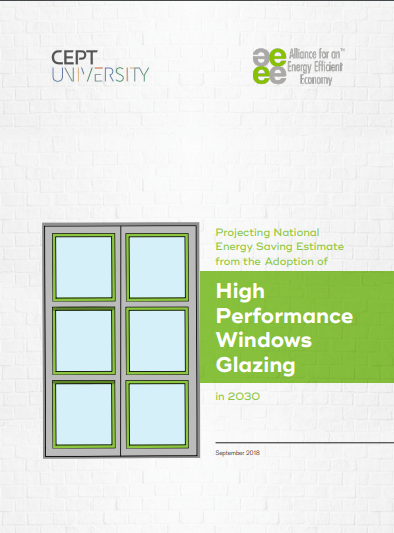Realising the unprecedented pace at which India is urbanising, AEEE follows a dynamic and evidence-based approach in our attempt to make Indian cities and buildings energy-efficient, climate-resilient, and sustainable. With growing socio-economic aspirations, quality of life in Indian cities, we at AEEE believe that optimising energy efficiency in buildings that are being constructed over the next two decades would play a decisive role in achieving India’s NDCs. Placed in the backdrop of India Cooling Action Plan, the team strongly advocates for ensuring thermal comfort for all, which in turn enhances productivity and contributes to societal well-being and public health.
Thermal Comfort for All
We are working towards accelerating our Lean, Mean and Green philosophy in-line with the ICAP’s predominant goal and recommendations of providing thermal comfort for all, by facilitating impetus through policy advocacy initiatives, for adopting sustainable and affordable space cooling technologies, adaptive thermal comfort practices and standards, and low-cost, low-energy centric building designs. This will contribute towards overall well-being, increased quality of life, and productivity of the dwellers.
Passive cooling strategies
Passive strategies are simple techniques that enable the indoor temperatures of a building to be moderated using natural energy sources. These strategies also help in reducing the energy need for space cooling and avoid the use of refrigerants. With the increasing climate-change impacts and rise in temperatures, the need for cooling for comfort will be unparalleled if interventions are not made right now.
AEEE’s line of work, current programs, and initiatives work towards implement ICAP recommendation on promoting low-energy cooling technologies, accelerate reducing cooling on buildings using passive design and technologies, identify and promote low-GWP or natural refrigerant-based cooling solutions, accelerate the adoption of passive cooling strategies and technologies in buildings, especially in the affordable housing segment of India.
Evidence-based: Policy Implementation
AEEE works closely with BEE and NITI Aayog to encourage the uptake of the Energy Conservation Building Code (Commercial and Residential). The team supports the Indian National and State governments to adopt appropriate sustainable building policies and energy codes that aid India’s Nationally Determined Contribution commitments to reduce the emissions intensity of its GDP by 33 to 35 percent by 2030 from 2005 level and exceed India’s commitments to climate action. We undertake a bottom-up approach for policy support, undertaking rigorous governance mapping, stakeholder consultation, and market assessment at the local level. Along with direct policy implementation, AEEE is also a part of the Climate Smart Cities Alliance which aims to make Indian cities more climate-resilient and sustainable.
Urban Cooling Plan
In the back-drop of the India Cooling Action Plan, there is a need to develop a context-specific city-level action plan which illustrates the city level goals, actions required, and strategies to make cooling accessible to all.
AEEE advocates a multidisciplinary, integrated approach along with technical solutions to deliver a holistic urban cooling action plan to make cities more equal and economically productive by proposing inclusive measures for various socio-economic groups within the city. For coherently enhancing the access to cooling, our work explores (but not be limited to) the following themes:
- Technology-based solutions and compliance with the existing policy frameworks
- Passive strategies for the city and buildings
- Monitoring and mitigating the cooling load and cooling energy usage.
Net-zero Buildings
Working towards the 1.5º C limit of the Paris Agreement requires decarbonization of the building sector. In India, the opportunity to do so is present in the new floor space to be constructed as the country develops and urbanizes. India is likely to move towards a Net-Zero Energy new construction policy similar to regulations in other countries around the world. This will require an NZE capable design-construction workforce that will grow at a rate of about 10% per year, a robust policy-framework that will enable net-zero and carbon-neutral building stock. AEEE is actively engaged with R&D institutions, international organizations, and Ministries to enable a resilient and sustainable built environment. AEEE’s ongoing efforts like Solar Decathlon India and other projects will provide a proven pathway to achieve this.
Smart Buildings
AEEE is committed to encouraging improved building energy efficiency and decarbonizing the built environment. With accelerated government efforts on (off/on-grid) renewable energy, electric vehicles, and building-integrated renewable technologies, the electricity distribution network and grid operation will face technological challenges. AEEE continues to work with state agencies, utilities, DISCOMs, government originations, and its members to focus on how these challenges can be overcome and pave policy pathways on how utilities can respond to this, and promote future-ready smart/grid-interactive buildings.
Building Stock Modelling
The building sector in India is experiencing unprecedented growth. The rise in building stock is driven by a robust demand-pull owing to growing urbanization, rising household income, growing requirement of space from sectors such as retail, education, and healthcare as well as a simultaneous policy-push with the introduction of several national missions such as Housing for All, Smart Cities and Solar Cities. It is contended that approximately 70% of the buildings required by 2030 have not been constructed yet.
The expected increase in residential as well as non-residential building stock in the coming years represents a tremendous and promising potential for strategically optimizing the rapidly increasing energy consumption in buildings. To support the design of any policy interventions based on data-driven and evidence-based research, AEEE is undertaking an exercise to estimate and characterize the commercial and residential building stock in India, which is especially important because of the Government of India’s initiatives such as ECBC and ECBC-R.

